![]()
![]()
![]()
Use LEFT and RIGHT arrow keys to navigate between flashcards;
Use UP and DOWN arrow keys to flip the card;
H to show hint;
A reads text to speech;
50 Cards in this Set
- Front
- Back

|
Anonymous, St. Francis Preaching to the Birds, fresco. 1290s (?), Upper Church, Basilica of San Francesco Assisi
The use of fresco, a fast-drying method of painting pigments onto plaster, is evident here through the lines of the background that show 2 distinct colors of blue (indicating that they weren't done on the same day). The subject matter, St. Francis, is a proponent in the church of seeing God in living things. His influence pushed the trend towards naturalism. |
|
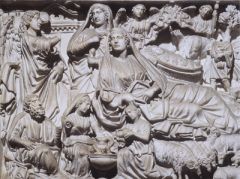
|
Nicola Pisano, Nativity. pulpit, marble. 1260, Baptistery, Pisa
Compared to earlier baptistries, this is much more detailed and the relief sculpture tells a complete story by using all of the space of the 6 sides to tell of Jesus' life. It took into account viewership. We see Pisano's influence from classical antiquity through the stoic expressions, Mary's lying position, contrapposto, and the drapery showing true shapes of the body. |
|
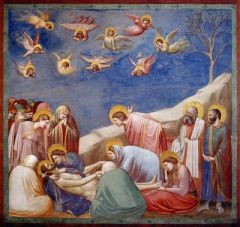
|
Giotto, Scrovegni Chapel, The Lamentation. 1305-6, Padua
The heightened emotion in the faces, the folds in the clothing, and the realistic stance of the characters shows the growing trend towards naturalism. This fresco is a stark contrast to the Assisi frescos of just a few years earlier. |
|
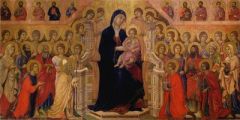
|
Duccio, Maestà, tempera/panel. 1308-11, Siena
Byzantine influence characteristic of the Italian Late Gothic period is seen through the iconic representation of Mary and the vast amount of gold leaf on the tempera. |
|
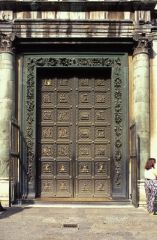
|
Andrea Pisano, South doors, Florence Baptistery
Through the lack of ornamentation (typical of the time, although holds quatrefoil shape), use of projecting ledges, and lack of a background, Pisano pairs down the composition to stress the narrative. |
|

|
Cimabue, Madonna Enthroned
Representative of the fusion of Byzantine and Italian artistic culture: gilding and iconic rendering of Mary shows a strong Byzantine influence, but the enormous size of the altarpiece was similar to other modern works of the time. The gilding also shows a more naturalistic approach, with lines following Mary's body instead of mere shapes and symbols. |
|
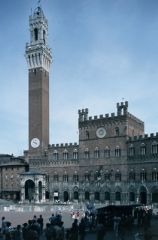
|
Siena, Palazzo Pubblico
Representative of the rivalry between Florence and Siena, as shown by the castle-like battlements, being intentionally taller, and more ornamental than the similar square/building being built in Florence at the time. |
|
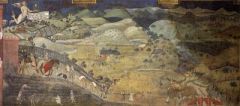
|
Ambrogio Lorenzetti, Good Government in the Country
The first image we know of since antiquity that focuses on landscape; a departure from the norms in the history of art. Used to show prosperity, wealth, fruitfulness of the land by focusing on the landscape and subordinating the figures. |
|
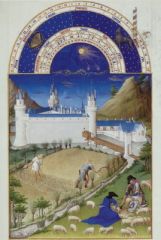
|
Limbourg brothers, July, Très Riches Heures, color, ink, parchment. 1413-16
The Book of Hours was an illuminated manuscript, which was an important medium of Northern Renaissance art. The bird's eye view and vast amount of detail are characteristic of the time and place. Oil paint is used to achieve the intricate amount of detail in the astrological figures of the top semicircular section. The gold leaf, lapis lazuli, and vellum backing shows the true wealth and richness of these books. |
|
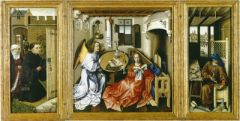
|
Robert Campin, Mérode Altarpiece (triptych), oil/panel. ca. 1425-30
This small devotional piece would have sat in someone's house or small chapel. The bird's eye perspective and great detail is characteristic of Flemish Early Renaissance painting. The detail in the scrolls, the codex, and the small lion on the chair are achieved through the use of oil paint. |
|

|
Jan van Eyck, The “Arnolfini” Portrait, oil/panel. 1434
detail, oil paint, |
|

|
Hieronymus Bosch, Garden of Earthly Delights, oil/panel. ca. 1480-1515
Resembles earlier works of the Last Judgement, with the saved on the left and the damned on the right. The meaning is unclear and debated, but it's thought to have been a large secular piece for a wealthy family intended to invoke conversation. Based on it's time of origin (~1500), it's possible that the thought of the apocalypse was in the artist's mind. |
|

|
Rogier van der Weyden, Descent from the Cross
Rogier's works focus to increase the expressive content of their subjects. By completely omitting a background, he is able to draw the viewer's full attention to the emotional impact of the scene. The expressions of grief and pain in the faces are stark, aided by the fine details achieved through the use of oil paint. |
|

|
Mary of Burgundy, Hours of Mary of Burgundy
A picture within a picture: unique from the norm of having a spatial context for the main image only. |
|

|
Michael Pacher, St. Wolfgang Altarpiece.
Still in it's original setting, which is rare for altarpieces. The intricate gold carving of the centerpiece is indicative of gothic influence, and there is a sharp contrast to the paintings on the wings. Use of linear perspective/viewer's vantage point is indicative of the author's journey to Italy. |
|

|
Martin Schongauer, Temptation of St. Anthony
This engraving has a complex design, spatial depth, and rich texture that is incredibly influenced by Rogier Van Der Weyden's work. Emphasis on the figure, and not the background, also is indicative of this influence. The use of crosshatching and shading to create the detail on the engraving is used deeply here. |
|

|
Filippo Brunelleschi, Dome of Florence Cathedral (Duomo). 1420-36
traveled to Rome - influence of antiquity |
|

|
Donatello, St. George Tabernacle, marble. ca. 1410-1417, Orsanmichele, Florence.
Schiacciato in the predella: in an emphasis to model antiquity. Effort for Pictorialism by Donatello (also evidenced by the shallow niche) |
|

|
Lorenzo Ghiberti, “Gates of Paradise”, gilt (gilded) bronze. 1425-1452, east doors, Baptistery of
San Giovanni, Florence, Removal of the quatrefoil frame to open the space for scientific perspective. Narrative. |
|

|
Donatello, David, bronze. ca. 1420s-1460s (Fig. 15.33)
quotes directly from antique model: Praxiteles. (stance, nakedness) Donatello's style is constantly evolving. David: patron of Florence. Thought of themselves as the underdog |
|

|
Masaccio and Masolino, The Tribute Money,
Brancacci Chapel, frescoes. 1425. Santa Maria del Carmine, Florence, Atmospheric and scientific perspective. Stark contrast to earlier frescos. Fresco secco (dry painting) is why some pieces are chipped off. |
|

|
Sandro Botticelli, The Birth of Venus, tempera/canvas (NOT panel). ca. 1485
Significant because it's on CANVAS not wood. New technology. Botticelli uniquely veers from naturalism. |
|
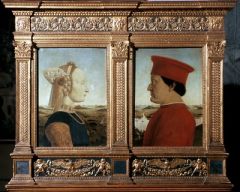
|
Piero della Francesca, Battista Sforza and Federico da Montefeltro, oil/tempera/panel. ca. 1472
Breaks with the convention of the man being presented on the left. Painted for the Urbino court, where Piero would have had interaction with Flemish painters. Became an early practitioner with oil painting in Italy, and shows his Flemish influence in the detail of the wife's headdress. Tribute piece for the wife. Atmospheric perspective. |
|
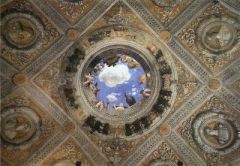
|
Andrea Mantegna, Camera Picta, frescoes. 1465-74. Ducal Palace, Mantua
refinement of the patron, learnedness, knowledge of antiquitism. tromp l'oeil. |
|
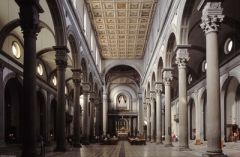
|
Brunelleschi, San Lorenzo
Attention to detail in proportions (even ratios, the bay of the nave is twice as wide as the side aisles), show's influence of antiquity/Brunelleschi's humanism. |
|

|
Gentile da Fabriano, Adoration of the Magi
Predella panel, the nativity. Uses light over line to describe the form. Illusionistic purpose, but also a symbolistic purpose. Deviating from traditional early Italian Renaissance art (emphasis on line) by doing so. |
|
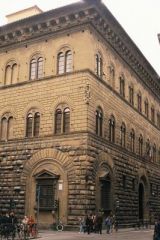
|
Medici Palace, Florence
Rustication: references to older Florentine fortress structures. Downplay ostentatiousness. elements of antiquity (roof, columns in arcade), but also traditional Florentine structure. |
|

|
Antonio del Pollaiuolo, Battle of the Nudes, engraving
The purpose of the engraving was to advertise Pollaiuolo's mastery of the nude body in action and advertise his skill. The fact that he signed the engraving supports this. The idea of painting the nude in action was a novel problem at the time, so he's giving special attention: the detail in the anatomy and physique is incredible. |
|
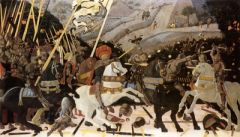
|
Paolo Uccello, The Battle of San Romano
We see scientific perspective in the foreground (falling soldier, weapons on ground), but its undermined by the flat background that tips upward toward the picture plane. He's showing his mastery of scientific perspective, but putting his own twist on it. |
|
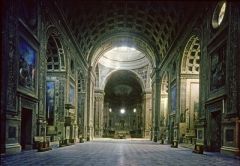
|
Leon Battista Alberti, Sant’Andrea, Mantua
Barrel dome (form design of an ancient Roman bath), colossal pilasters express Alberti's goals of using classical architecture in a Christian space of worship, but stays true to the basilican shape. Humanist goal of synthesizing ancient Roman forms with Christian worship. |
|

|
Giovanni Bellini, S. Francis in the Desert
Hybrid: combines techniques of oil painting learned from the Flemish (detail, sandals, desk) and the Florentine scientific perspective, with the Venetian elements of soft color, soft light. |
|
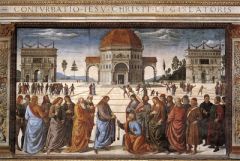
|
Pietro Perugino, The Delivery of the Keys, Sistine Chapel
Even distribution of figures, strong scientific perspective. puts the emphasis on the center: Peter receiving the Keys to Heaven from Jesus. Important because commissioned for the Sistine Chapel (which was built especially for the Pope). |
|

|
Leonardo da Vinci, Mona Lisa, oil/panel. ca. 1503-05
Florentine profile moves into 3/4's view: the gaze, background: believable human being. Sfumato (hidden by smoke), uses oil glazes to experiment with giving the figure and atmosphere a sense of presence by softening the contours. Chiaroscuro (light/dark). |
|

|
Michelangelo, David, marble. 1501-4, Florence
Hands are bigger, captures the divine moment of realization: drama. The epitome of rationalist thought. Michelangelo shows off his talent here, by working to get so much detail, movement, lifelikeness out of such a tall and narrow piece of marble. The grain of the stone was used to add lifelike quality, like skin/veins. |
|
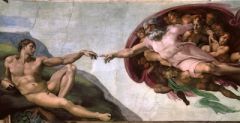
|
Michelangelo, ceiling fresco. Creation of Adam. 1508-12, Sistine Chapel, The Vatican, Rome
Michelangelo was able to create illusionistic space and refine his technique to work on a curved ceiling with scientific perspective. Tremendous feat. Was able to take into account the viewer. He clarified the work and broke it down to the essentials so that the viewer would get it from where they were standing. |
|

|
Titian and Giorgione, Fête Champêtre (Pastoral Concert), oil/canvas. ca. 1509-10
colorito (Venice) allegory/meditation. |
|

|
Leonardo da Vinci, The Last Supper
Scientific perspective: all elements of the picture - light, composition, colors, setting - focus the attention on Jesus |
|

|
Bramante, Tempietto "Little Temple"
Example of Early Italian Renaissance's desire to emulate to exactness of classical Roman proportions (columns 4x the diameter). The circle and square as ideal forms. |
|

|
Raphael, School of Athens
Classical building, scientific perspective, philosophers shown are direct links to antiquity |
|

|
Andrea Palladio, Villa Rotunda. ca. 1567-70, Vicenza
Using elements of classical architecture in a novel way. Using traditional forms for a secular space. 4 sided, placed up on knoll, emphasis on views was new to the time. |
|

|
Titian, Venus of Urbino, oil/canvas. ca. 1538
Ambiguity of the subject manner: a commentary on marriage? the owner of the picture called it a naked woman. emphasis of Colorito >> vs desingo: artist works directly on the support. focuses on brilliant pictorial effects. |
|

|
Jacopo da Pontormo, Entombment (or Pietà)
Mannerism. artist is attempting to show his virtuosity and skill (elongated figures, compressed space, expression). capacity to deviate from high renaissance standards. |
|

|
Giovanni Bologna, The Rape of the Sabine Woman
artists capacity to show his skill, talent: contract between form and content of Mannerism is vividly clear here. |
|

|
Michelangelo, Last Judgment, Sistine Chapel
-last of the pieces: his abilities have reached their peak. Brilliant colors, compressed space of the figures, dramatic composition reflect Mannerism. |
|
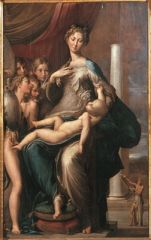
|
Parmigianino, Madonna with the Long Neck, oil/panel. ca. 1535
Manneristic: deviation from the order of prior Renaissance pieces. Unbalanced composition and long neck, oval-like head, boneless hand, idealized nature typical of mannerism. |
|
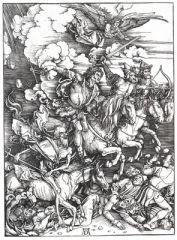
|
Albrecht Dürer, Four Horsemen of the Apocalypse, woodcut. 1498
incredibly talented, detail in the woodcut: 1500 apocalyptic. |
|
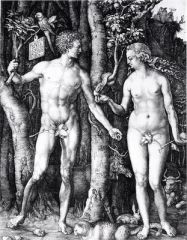
|
Dürer, Adam and Eve, engraving. 1504
durer, the man who wants to become famous, comes to life. Clearly modeled Eve after the Medici Venus and Adam on the Apollo Belvedere. Clear Italian classical influence from his travels, but the use of other figures in the background that were symbolistic/detail is representative of Northern art. |
|

|
Pieter Bruegel, Return of the Hunters, oil/panel. 1568
Strong diagonal, use of perspective and space, indicative of Italian influence. The flattening of the figures is old fashioned: Flemish art. |
|

|
Matthias Grünewald, Isenheim Altarpiece
Utterly strange, weird, non-Italian. Hierarchical scale: Christ is so much larger than anyone else. Emphasizes heroism and suffering of the Christ, the drama of the piece. Destination: monastery where people were being treated for St. Anthony's Fire. Transition to the healing of the body of Christ from the suffering body, to the patients who were also suffering. Reduction of the range of the palette emphasizes the drama (white and red:passion) of the scene depicted. |
|

|
Bruegel, Peasant Wedding
Scientific perspective is indicative of Italian Renaissance influence |

